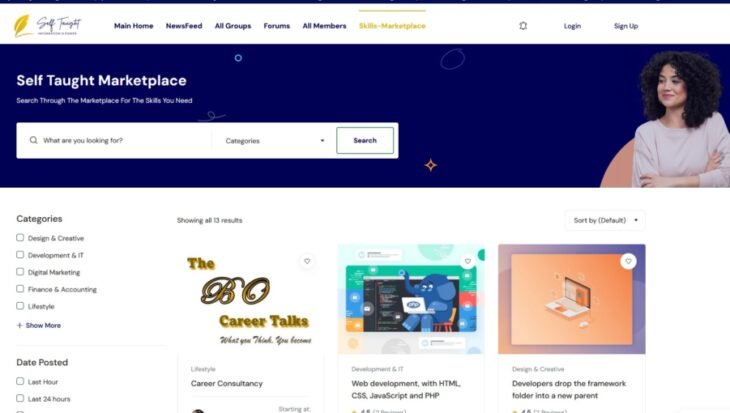Gaining a Tangible skill set requires grit and perseverance. But with time and practice, you can achieve a high level of mastery. The rewards of developing a new skill set through self-study are beneficial. You gain valuable expertise and build confidence in your abilities.
Introduction to Self-Taught Academy
So you want to pick up a new skill but don’t have the time or money to go back to school? Check out Self-Taught Academy. Our innovative online learning platform offers Long and short courses to help you master real-world skills.
Learn at Your Own Pace
Self-Taught Academy lets you learn on your schedule. Most courses only take a few hours; you can start and stop whenever you want. Whether you have 30 minutes on your lunch break or a free evening, you can easily fit in a lesson.
Build Practical Know-How
The courses at Self-Taught Academy teach skills you can apply right away. Learn to touch type, create a budget, speak basic Spanish, build a website, and more. Each course’s projects and interactive exercises help reinforce what you’re learning so you gain experience, not just theoretical knowledge.
Affordable and Accessible
Self-Taught Academy aims to make useful skills accessible to everyone. Courses are very affordable, ranging from $20 to $50. And since everything is online, you only need an internet connection to get started. For people with busy lives or limited means, Self-Taught Academy is a great way to learn valuable skills on a budget.
Whether you want to advance your career, pursue a hobby, or expand your knowledge, Self-Taught Academy has a course for you. Check out their catalogue today and start learning a new skill this week! With hard work and the right resources, you absolutely can teach yourself. Self-Taught Academy provides an easy and affordable way to do just that.
Top 5 Tangible Skills You Can Learn From Home
Learning a new skill is challenging but rewarding. Here are five tangible skills you can pick up from home:
Cooking
Cooking is a life skill everyone should have. Start with basics like cooking rice, eggs, and vegetables. Watch video tutorials to learn techniques, then practice. Once you’ve mastered the fundamentals, try making simple dishes like stir-fries, pastas, and curries. Home cooking saves money and is healthier than eating out.
Coding
Coding is a valuable skill in today’s digital world. You can learn to code for free using websites like Codecademy, Udacity, and Coursera. They offer interactive courses in languages like Python, HTML, CSS, and JavaScript. Start with the basics, then build simple web pages or apps. Coding teaches you logic and problem-solving skills that apply to many areas of life.
Photography
Anyone can become a photographer with a decent camera or smartphone and some practice. Learn the fundamentals of composition, lighting, and editing. Start by practicing around your home, shooting still lifes, portraits, or landscape photos. Once you’ve developed an eye for it, you can move on to more advanced techniques. Photography is a fun, creative outlet, and useful artistic skill.
Graphic Design
Graphic design skills are in high demand. You can teach yourself design basics using free or low-cost software like Canva, GIMP, or Inkscape. Learn principles of layout, typography, branding, and UX design. Start by creating simple designs like flyers, social media posts, or web banners for a small business or non-profit. Build up a portfolio of work to help land freelance clients or a job.
Foreign Language
Learning a new language expands your mind and opens you to different cultures. Choose a language you’re passionate about and immerse yourself in it. Use apps, audio lessons, podcasts, books, movies, music, and online tutoring. Start with practical phrases and vocabulary, then learn grammar and pronunciation. Speaking with others is the best way to become fluent. Learning a foreign language takes dedication but can be life-changing.
Choose Your Preferred Learning Style
The way you prefer to learn new skills can determine which online course is the best fit for you. There are three main learning styles to consider:
Visual
If you’re a visual learner, you prefer learning through images, video, and graphics and seeing what you’re learning in action. Look for courses that provide video tutorials, interactive elements, photos, infographics, and visual examples. Some good options for visual learners include:
- Udemy offers video-based courses with interactive coding exercises, visuals, and examples.
- Coursera – They provide video lectures, slides, interactive elements, and visuals to demonstrate key concepts.
- Udacity – Their courses include hands-on video tutorials, coding exercises, interactive examples, and visuals.
Auditory
If you learn best by listening, auditory courses with audio lectures, podcasts, and discussions will suit you well. Some recommendations include:
- edX – They offer video lectures, audio podcasts, and interactive forums where you can discuss topics with other learners and instructors.
- Udemy – Some instructors provide video lectures, audio podcasts, Q&A sessions, and opportunities for discussion in the course forums. Look for courses taught by instructors with teaching experience.
- Coursera – Their courses include video lectures, audio podcasts, and discussion forums to interact with peers and instructors.
Kinesthetic
If you prefer a hands-on, learn-by-doing approach, kinesthetic or interactive courses will be most effective. These include:
- Udacity – Their courses focus on hands-on video tutorials, coding exercises, interactive examples, and projects to apply what you’ve learned.
- edX – Some courses offer interactive coding exercises, simulations, virtual labs, and projects to put skills into practice.
- Udemy – Look for courses that provide interactive coding exercises, projects, quizzes, and opportunities to apply your learning through real-world examples.
The key is to choose courses that align with your preferred learning style so you can master new skills as efficiently and enjoyably as possible. With the range of interactive online courses available today, there are many options for any learning preference.
Structuring Your Learning Schedule
Structuring your learning schedule is key to mastering a new skill efficiently. The good news is with self-study, you can create a schedule tailored to your needs and learning pace.
Set a Routine
The first step is establishing a routine for your study time. Pick 2-3 times weekly to focus on your skill development and block off those times in your calendar. Treat these sessions as seriously as any other appointment or work commitment. Starting a routine will help make learning a habit and keep you accountable. Try mornings, nights, or weekends – whatever suits your schedule.
Within your routine, set concrete and achievable goals for each session to keep you on track. Maybe you aim to complete one module or lesson. Or maybe you set a timer for 60-90 minutes of focused work. Track your progress to stay motivated as you improve over time.
Mix Up Your Activities
While consistency is key, mixing up how you’re learning within your routine is also important. Combine reading, video tutorials, hands-on practice, quizzing yourself on new concepts, and finding ways to apply your new skills in real-world or simulated scenarios. This variety will keep things interesting and activate different parts of your brain, improving retention and understanding.
Dedication and employing proven learning strategies are the key to mastering a new skill through self-study. Stick to a routine, set concrete goals, and vary your activities to keep things engaging. With consistent practice, you’ll be amazed at the progress you can make and the skills you can acquire through self-teaching.
Measuring Your Progress and Setting Milestones
To master a new skill, you need to track your progress and set milestones to stay on track. As you work through the courses and projects in Self-Taught Academy, use these techniques to ensure you’re gaining real proficiency.
Set specific and measurable goals.
Don’t just say you want to learn coding or design a website. Break it down into concrete steps, like completing a certain number of courses each month or building a basic web page by a target date. Review and revise your goals regularly to keep improving.
Track your key metrics.
Come up with a few key numbers or stats to monitor how you’re progressing, such as hours practicing each week, projects completed, or skills acquired. Use a simple spreadsheet, calendar, or app to record your metrics. Look for trends over time to see how you improve and make changes as needed.
Celebrate wins, big and small.
Learning a new skill takes dedication, so pat yourself for all your accomplishments. Have you finished a challenging course? Built your first web page? Solved a tricky coding problem? Congratulate yourself for these victories, not just the major milestones. Reward yourself in small ways to stay motivated for continued progress.
Get feedback
Ask others to review your work, check your progress, and provide constructive criticism. Share your projects, designs, or code with peers in the Self-Taught Academy community and ask for their input. Look for field mentors who can guide you to help improve your skills. Accept all feedback graciously—it will only make you better.
Measuring your advancement, setting achievable goals, acknowledging wins, and getting input from others are key strategies for mastering a new skill. Stay dedicated, work hard, and keep practicing. You’ll gain proficiency and confidence through Self-Taught Academy.
So there you have a few compelling reasons to choose Self-Taught Academy. Whether you want to learn how to code, learn a new language, master photography, or even learn a musical instrument. We have you covered. Our community of expert instructors and interactive learning experience will have you well on your way to acquiring a new skill in no time. The best part is you can learn at your own pace and schedule. The possibilities are endless when you open yourself up to continuous learning.












